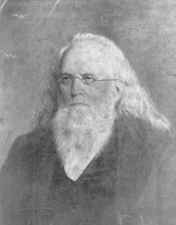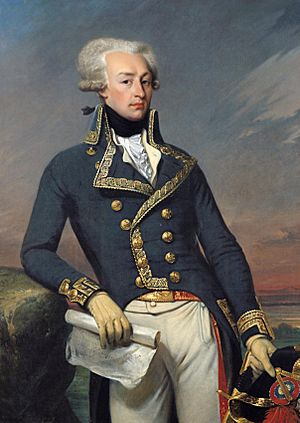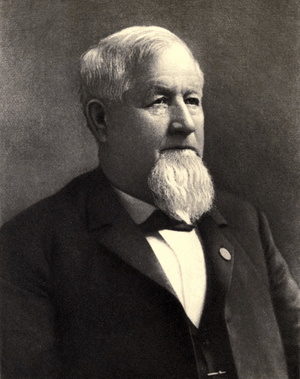Sidney Breese facts for kids
Quick facts for kids
Sidney Breese
|
|
|---|---|
 |
|
| Chief Justice of the Illinois Supreme Court | |
| In office 1873–1874 |
|
| Preceded by | Charles B. Lawrence |
| Succeeded by | Pinkney H. Walker |
| In office 1867–1870 |
|
| Preceded by | Pinkney H. Walker |
| Succeeded by | Charles B. Lawrence |
| 15th Speaker of the Illinois House of Representatives | |
| In office January 6, 1851 – January 3, 1853 |
|
| Preceded by | Zadok Casey |
| Succeeded by | John Reynolds |
| United States Senator from Illinois |
|
| In office March 4, 1843 – March 3, 1849 |
|
| Preceded by | Richard M. Young |
| Succeeded by | James Shields |
| Justice of the Illinois Supreme Court | |
| In office 1857–1878 |
|
| Preceded by | Walter B. Scates |
| Succeeded by | David J. Baker Jr. |
| In office 1841–1843 |
|
| Succeeded by | James Semple |
| Personal details | |
| Born | July 15, 1800 Whitesboro, New York, US |
| Died | June 27, 1878 (aged 77) Pinckneyville, Illinois, US |
| Resting place | Carlyle, Illinois |
| Political party | Democratic |
| Spouse | Eliza Morrison |
| Alma mater | Hamilton College Union College |
| Occupation | lawyer, jurist, author |
| Signature | |
| Military service | |
| Allegiance | United States |
| Branch/service | Illinois Militia |
| Rank | Lt. Colonel |
| Battles/wars | Blackhawk War |
Sidney Breese (July 15, 1800 – June 27, 1878) was an important figure in early Illinois history. He was a lawyer, soldier, and writer. Breese served as a United States Senator for Illinois. He also became Chief Justice of the Illinois Supreme Court. People often call him the "father of the Illinois Central Railroad" because of his efforts to build it.
Contents
Early Life and Family
Sidney Breese was born in 1800 in Whitesboro, New York. His father was Arthur Breese and his mother was Catherine Livingston. Sidney's mother passed away when he was eight years old.
His Education
Sidney was a very smart student. He started Hamilton College when he was only 14. Later, he moved to Union College in 1816. In 1818, he graduated as one of the top students in his class. After moving to Illinois, he studied law.
His Family Life
In 1823, Sidney Breese married Eliza Morrison. They had a large family with fourteen children. One of his sons, Livingston Breese, served in the U.S. Navy during the American Civil War. Another son, James Buchanan Breese, served in the Marine Guard during the Civil War.
Becoming an Illinois Pioneer

After college, Sidney Breese moved to Illinois. He became an important pioneer in the state.
Working for the State
Illinois became a state in 1818. Sidney's cousin, Elias Kent Kane, became the Illinois Secretary of State. Kane hired Breese as his assistant. Breese also became a lawyer in Illinois in 1821.
In 1820, the capital of Illinois moved from Kaskaskia to Vandalia. Breese was in charge of moving all the state records by wagon. He worked as Assistant Secretary of State until 1821. Then he started his own law practice in Kaskaskia.
Early Legal Work
In 1822, Breese became a prosecutor for the Third Judicial District in Illinois. Later, in 1827, U.S. President John Quincy Adams appointed him as a United States Attorney for Illinois. He held this job until 1829.
After leaving his government job, Breese started collecting and publishing reports from the Illinois Supreme Court. These books were called the "Breese Reports." They were the first books ever published in Illinois.
Serving in the Black Hawk War
In 1832, the Black Hawk War began. Sidney Breese volunteered to serve in the military. He started as a private, but was soon elected a Major. Later, he was elected Lieutenant-Colonel. Future U.S. President Zachary Taylor and Civil War General Robert Anderson served under his command.
More Legal and Political Roles
After the war, Breese went back to practicing law. He also helped with land claims in the new town of Chicago.
Becoming a State Judge
In 1835, Breese was appointed a judge for the 2nd Circuit Court in Illinois. In 1841, he became a Justice on the Illinois Supreme Court. Other important figures, like future U.S. Senator Stephen A. Douglas, also joined the court at that time.
Serving in the U.S. Senate
In December 1842, Sidney Breese was elected as a United States Senator for Illinois. He was a member of the Democratic Party. During his time in the Senate, he focused on his duties and helping the people of Illinois. He worked with future President Abraham Lincoln, who was in the U.S. House of Representatives at the time.
Breese achieved several important things as a Senator. He led the Public Lands Committee. This committee was very important for Illinois. He turned down a more famous role to lead this committee. He wanted to help get a transcontinental railroad built for his state. He also served on the board of the Smithsonian Institution.
Key Issues in the Senate
- Texas Annexation: Breese strongly supported adding Texas to the United States. He helped pass laws to make this happen in 1845.
- Mexican-American War: He supported the Mexican–American War. He gave a famous speech about war tactics, disagreeing with Senator John C. Calhoun.
- Oregon Treaty:
Breese was an expansionist, meaning he wanted the U.S. to grow. He did not like the Oregon Treaty of 1846 with Great Britain. He believed the U.S. should have more land in the Pacific Northwest.
- Tariff Act of 1846: He cast the deciding vote for the Tariff Act of 1846, which changed taxes on imported goods.
The Illinois Central Railroad
Sidney Breese worked for many years to get a railroad built in Illinois. He started pushing for it in 1835. He wanted a railroad to connect the Illinois and Michigan Canal with the Mississippi River. This would help connect the country from coast to coast.
As a Senator, he introduced laws to get land grants from the government for the railroad. He wrote important reports explaining why the railroad was so important. He said it would connect the country in just four days!
His hard work paid off. In 1850, after he left office, the railroad bills were passed. The Illinois Central Railroad Company was officially started in 1851. It received the land grants from the federal government. Because of his efforts, Sidney Breese is known as the "father of the Illinois Central Railroad."
Speaker of the Illinois House of Representatives
In 1850, Breese was elected to the Illinois House of Representatives. He was immediately chosen to be the Speaker, which is a very important leadership role. He served in this position until 1852.
Return to Private Life and Judiciary
After leaving the House, Breese returned to his law practice. People often suggested he run for Governor or even President, but he did not.
Serving as a Judge Again

In 1855, Breese accepted a job as a Circuit Court Judge. Then, in 1857, he was elected as a Justice to the Illinois Supreme Court. He served on this court for the rest of his life. He was even the Chief Justice multiple times. By this time, he was living in Carlyle, Illinois.
During the Civil War
During the American Civil War, Sidney Breese was an older leader in the Democratic Party. He believed in states' rights but was against states leaving the Union. Two of his sons fought for the Union during the war.
As an Author
After the transcontinental railroad was finished, Breese wrote books about history. In 1869, he published a book about Illinois history. He also wrote a book called Origin and History of the Pacific Railroad.
Death and His Legacy

Sidney Breese passed away in Pinckneyville, Illinois, on June 27, 1878.
He was known for being very generous and giving his money to many good causes. He was also known for being a fair judge who prevented corruption. He encouraged young people who were studying law. The Illinois State Historical Society keeps his letters and papers. These include letters from important people like U.S. Senator Stephen A. Douglas and U.S. President Martin Van Buren.
The town of Breese, Illinois, is named in his honor.



